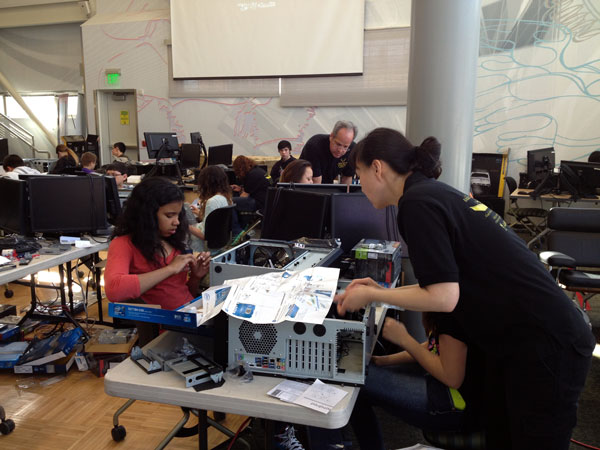
Building a computer is child’s play, or at least it ought to be. That’s the premise behind an innovative concept in science and engineering education. As KSKA’s Ellen Lockyer reports, the Matanuska Susitna Borough School District has partnered with UAA’s Alaska Native Science and Engineering Program, or ANSEP, to help middle schoolers achieve future university success.
“You should not need a screwdriver “…
An instructor calls out directions to a room full of kids who are working to fit tiny components together inside an otherwise empty computer case. Jackson Peters is a Wasilla sixth grader. He seems undaunted by the task at hand. I ask him to describe what he’s looking at.
“..so the bottom blue is the mother board, and then we have the RAMS, and then we have the heater like thing that cools it down, ” Yeah, the fan. ” yeah we have the fan and then we have the fan wires….”
Jackson is one of 54 sixth and seventh graders gathered in the ANSEP common room at UAA. He is reading instructions printed on a glossy sheet of paper, while ANSEP instructor calls out encouragement over the room’s scratchy wireless sound system.
The Mat Su School District middle schoolers are here to take part in the science and engineering camp ANSEP hosts every year. Dr. HerbSchroeder founded ANSEP about a dozen years ago
“It’s all about raising the bar and showing kids that they can do things that they might not necessarily consider, “ he says.
The camp is actually a 12 day activity — computer building is only part of it. The students will do some hands on engineering projects, and some hydrology work with the Forest Service to get a broad feeling for what it is like to be a scientist and engineer. The students will even dissect squid.
The program is an attempt to boost the flagging numbers of Alaska Native students who are ready for college level studies. Schroeder is outspoken about how the established education system is letting Alaska Native students down.
“Forty percent of our Alaska Native kids never graduate from high school on time. We’re spending money in ways that are not changing that number. We need to stop this. I call it paying for failure, “ he says.
The students have have taken a short break for snacks and a bit of horsing around, but now it’s time to get back to work. Two girls bend their heads over their projects.
Erin Sherman and Alissa MacLaine are sixth graders. They say after the computers are done, they will be able to use them. “Hopefully, ” Erin says, or “my ego will be damaged forever” They both laugh. Asked if the project is difficult, Alissa says that it’s not too difficult. “For you” the girls say in unison, and laugh some more. Alissa says she just looks at the pictures on the instructions mostly.
This is the first time the ANSEP Middle School academy is happening before summer vacation and it’s important, because it is also the first time that an entire school district is taking part. Schroeder says in the past, students were selected one or two at a time from a number of rural school districts.Mat Su School District superintendent Dr. Deena Paramo says two hundred students applied for the program from her district this year.
“And our goal really is to open up doors for these kids and have them challenge us. They are building a computer and they get to keep that computer. Their skin in the game is that these kids are to take algebra by eighth grade, and just challenging themselves academically to move forward in high school as well as be ready for college, ” she says.
Schroeder says ANSEP wants to extend its model of introducing math and science challenges to elementary and middle school students to twelve school districts around the state by 2018.
“And the most significant thing about the middle school academy is that, in the nation, 26 percent of eighth graders graduate with algebra one sucessfully completed. ANSEP students graduate eighth grade with algebra one completed at a rate of 83 percent, so we are more than three times better than the national average, “ he says.
Paramo says the school district’s part in the program was helped along by state STEM and Knik Tribe funds.
“It’s just an opportunity that we wanted to offer our kids and being innovative in new programs, and hopefully creating a pipeline for these kids to be engineers if they’d like, and opening those doors.” she adds.
Schroeder says he wants 3000 Alaska Native students in that pipeline by 2020 .. students from sixth grade to PhD candidates.
APTI Reporter-Producer Ellen Lockyer started her radio career in the late 1980s, after a stint at bush Alaska weekly newspapers, the Copper Valley Views and the Cordova Times. When the Exxon Valdez ran aground in Prince William Sound, Valdez Public Radio station KCHU needed a reporter, and Ellen picked up the microphone.
Since then, she has literally traveled the length of the state, from Attu to Eagle and from Barrow to Juneau, covering Alaska stories on the ground for the AK show, Alaska News Nightly, the Alaska Morning News and for Anchorage public radio station, KSKA
elockyer (at) alaskapublic (dot) org | 907.550.8446 | About Ellen




